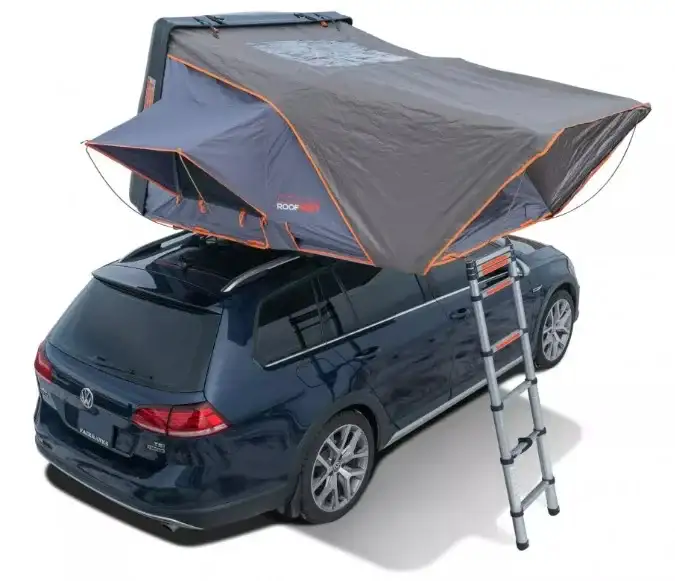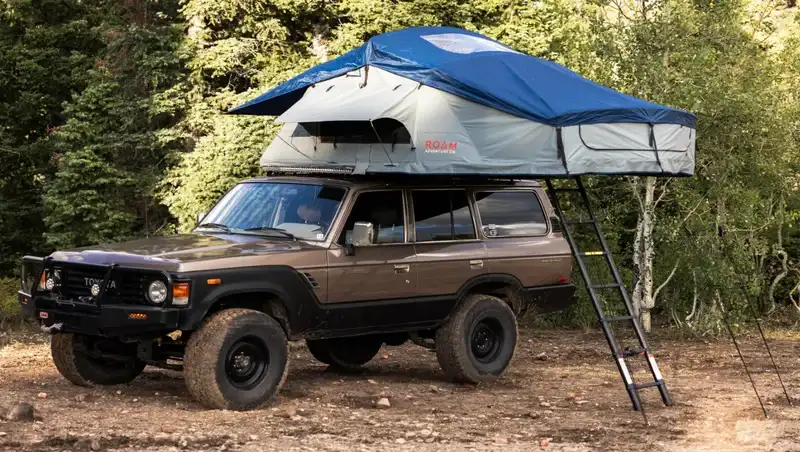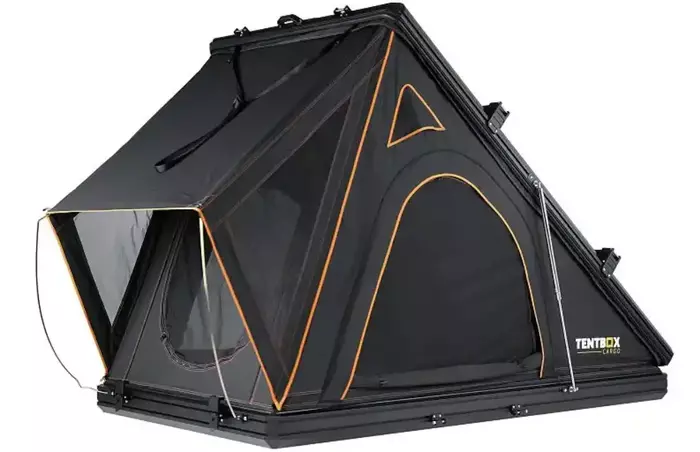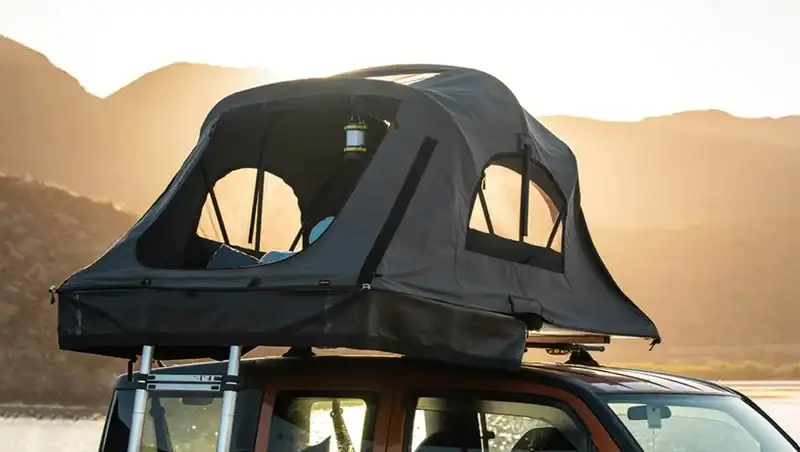Ventilation in rooftop tents may be very different when the sky is clear, and when it rains. You have a variety of ways to vent the space in such different conditions.
Rooftop tents normally always have windows with mesh and panels at least on three sides, sometimes on all four sides, plus one or two skylight windows in some of them. So when the sky is clear, you can have as much ventilation as you want.
When it rains, you may be forced to close at least some, or all side windows. In this case, you can rely on skylight windows and also on vents, assuming that the tent has them. If you do not have any, then your rooftop tent is poorly designed for rain conditions.
Why does ventilation matter
A roof top tent is normally well above ground, and if there is even a bit of wind, you may have plenty of air flowing through it. Imagine how better this may be if you compare it to a ground tent with a full coverage fly.
So this is not just about great views, rooftop tents almost always provide much better air circulation than most of ground tents. But rooftop tents are also usually smaller than many ground tents, and if there are two or three occupants, there will be lots of vapor which they exhale.
This is why it is essential to keep the air circulation through the tent. With this you reduce chances for condensation, mold growth, and also carbon dioxide buildup.
Namely, we inhale air that includes 21% of oxygen and 0.04% of carbon dioxide. But we exhale around 16-17% of oxygen and 4% of carbon dioxide.
So if there is no air flow and ventilation, the atmosphere in your rooftop tent may become quite unpleasant. In the case of long intervals with rain when you keep the tent closed, this can become a problem.
How ventilation works in a rooftop tent
There are several separate elements to consider, so here they are:
Windows & doors
This is about natural ventilation through windows and doors. Yes, I am talking about doors in plural because it is quite frequent to have three doors on a pop-up roof top tent and also on a clamshell tent.
This includes a zippered mesh and a zippered panel on each of these openings. So if you use one as a door, then the remaining can be used as windows.
In soft shell tents you mostly have only one door, and the remaining openings are then windows. So in this type of roof top tents you can have openings on all four sides. The top picture above shows one great example, the iKamper X-Cover 2.0 Mini.
As you realize, with such a design, you can have cross flow in various directions, and you can regulate it.
The only negative side of this ventilation option is that it may be reduced in the case of strong wind and rain combined. This is because in such circumstances you might be forced to close everything. So let’s see what else remains.
Skylight windows
This type of opening is typically found in the so-called expandable clamshell roof top tents. The Roofnest Condor in the picture below is one example.

There are also soft shell roof top tents with the same feature, you can see it in the Crua Outdoors AER Maxx. Some of them can have two skylight windows, the Roam Adventure the Vagabond XL Rooftop Tent is such an example, see the picture below.

One great fact about this feature is that you can use it even when it rains. This is because such tents normally have a fly that protects the skylight window. The fly itself can have a vinyl window that matches the skylight, you can see it in the picture above.
But more importantly, this skylight window can be used as an excellent roof vent. This means you can keep it with mesh, plus the fly above it. So you can have ventilation and still have light through the vinyl window.
This is particularly useful in the case of wind and rain combined. In such intervals you may be forced to close all the sides windows ad their awnings, but you will have a great venting option on the roof.
So compared to venting options through side windows here you have the following:
- This venting can be used all the time.
- But this is a roof vent, and it is most effective if it can be combined with any of the side windows or the door, to generate vertical air flow.
Vents
It is interesting that not all rooftop tents have vents. This is a must if you have to keep side windows closed.
Vents are usually located on the sides and under the roof. The picture below shows one example, this is TentBox Cargo. The vent is that small triangular element above the side window. You have yet another on the opposite sides.

You realize that this is a small opening, so this is mainly for emergencies and it cannot be used as the main venting option. It is best to use it in combination with some low vent (side window).
So if it rains and if you have one window that is less exposed to the wind, perhaps you can keep it at least partly open and combine with those high vents.
Factors affecting ventilation in a rooftop tent
From the text above, you already have some idea about this topic. So the factors include:
- Weather conditions: If this is just a light rain and with not much wind, you can keep your awnings on, and windows with mesh. This will give you lots of fresh air to enjoy the rain from the safety of your tent.
- Tent design: Regarding the design, the more windows the better. This will create cross flow and make the atmosphere pleasant.
- Tent material: Many rooftop tents are built from a breathable polycotton fabric. This is a pleasant material that performs better than any synthetic fabric. However, most of them are actually coated and have a high waterproof rating. But this means they are not really breathable.
- Occupancy and body heat: We normally produce heat, and in a limited volume like a rooftop tent, this can be obvious. This combined with breathing can indeed affect the air quality inside the tent, in particular if this is about 2 people or more. Physical activities only makes things worse. So consider waiting with sex if you are forced to keep the windows closed.
- Altitude and air pressure: At higher altitudes you will experience a lower air pressure and less oxygen in the air. You may find it harder to breathe, so make sure to open windows as much as you can so that you can have a steady supply of fresh air.
Tips for maximizing ventilation in a rooftop tent
Assuming that you do not expect very strong winds, it may be good to find a campsite with good airflow, such as a high ground and at open spaces.
You know already that rooftop tents have many windows, so orient the car in such a way to optimize ventilation. This means positioning windows and doors strategically, and avoiding obstructions.
Make sure to use pleasant bedding and clothing. Avoid synthetic and use natural and breathable materials.
Final thoughts
In summary, rooftop tents are equipped with several features for optimal ventilation. All of them come with mesh openings on at least three sides, plus skylight mesh windows and high vents in some of them.
So use these features to avoid condensation and related mold growth, and also to reduce carbon dioxide buildup. This is a guarantee for a comfortable and safe camping experience in your rooftop tent.
Once you are in the tent, you can experiment with different ventilation strategies. This will allow you to find out what works best for your current camping environment and weather conditions.
Let me know if you have questions, there is a comment box below. Bookmark this site and keep as a reference. You will always have new texts added here and this will keep you informed. Thank you for reading and have a nice day.

 Hi, I am Jovo, the founder of this Off-Ground Tents site and several other outdoor sites. I have been mountaineering for almost 40 years already, and I have created this site to use as a reference for various types of above ground tents.
Hi, I am Jovo, the founder of this Off-Ground Tents site and several other outdoor sites. I have been mountaineering for almost 40 years already, and I have created this site to use as a reference for various types of above ground tents.